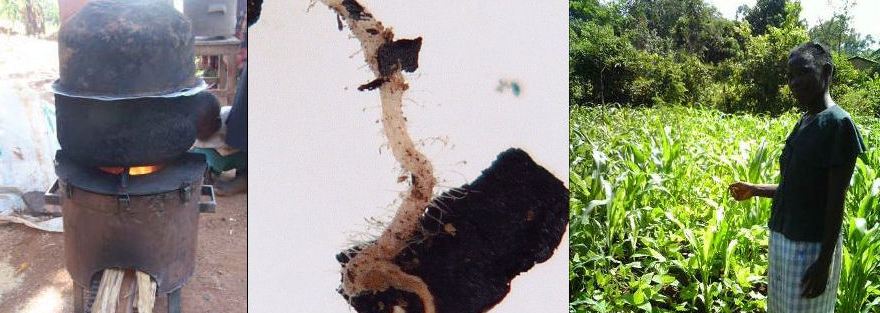References and Reading:
Ahmed A, Vargas Hill R, Smith LC, Wiesmann DM, Frankenberger T 2007. The world’s most deprived: Characteristics and causes of extreme hunger. 2020 Discussion Paper No. 43, International Food Policy Research Institute, Washington D.C.
Kimetu J, Lehmann J, Ngoze S, Mugendi D, Kinyangi J, Riha S, Verchot L, Recha J, Pell A 2008. Reversibility of soil productivity decline with organic matter of differing quality along a degradation gradient. Ecosystems 11: 726-739.
Lal R 2006. Enhancing crop yields in the developing countries through restoration of the soil organic carbon pool in agricultural lands. Land Degradation and Development 17: 197–209.
Lehmann, .J, Gaunt, J. and Rondon, M.: 2006, 'Bio-char sequestration in terrestrial ecosystems – a review', Mitigation and Adaptation Strategies for Global Change 11, 403-427.
Lehmann, J.: 2007, 'A handful of carbon', Nature 447, 143-144.
Marris, E.: 2006, 'Black is the new green', Nature 442: 624-626.
Ngoze S, Riha S, Lehmann J, Kinyangi J, Verchot L, Mbugua D, Pell A 2008. Nutrient constraints to tropical agroecosystem productivity in long-term degrading soils. Global Change Biology 14: 2810-2822.
Okello BD, O’Connor TG, Young TP 2001. Growth, biomass estimates and charcoal production of Acacia drepanolobium in Laikipia, Kenya. Forest Ecology and Management 142:143-153.
Rehfuess E, Mehta S, Prüss-Üstün A 2006. Assessing household solid fuel use- multiple implications for the Millennium Development Goals. Environmental Health Respect 114: 373-8.
Sanchez PA 2002. Ecology - Soil fertility and hunger in Africa. Science 295: 2019- 2020.
Smith KR 2008. Wood, the Fuel that Warms You Thrice. pp 97-111. In Colfer CJP (ed.), Human Health and Forests: A Global Overview of Issues, Practice, and Policy. Earthscan, London.
Solomon D, Lehmann J, Kinyangi J, Amelung W, Lobe I, Ngoze S, Riha S, Pell A, Verchot L, Mbugua D, Skjemstad J, Schäfer T 2007a. Long-term impacts of anthropogenic perturbations on the dynamics and molecular speciation of organic carbon in tropical forest and subtropical grassland ecosystems. Global Change Biology 13: 511-530.
Vajpeyi DK 2001. Deforestation in the Democratic Republic of Congo and Kenya. In Vajpeyi DK (ed.) Deforestation, Environment and Sustainable Development: A Comparative Analysis. Praeger, Westport, CT.
Wamukonya L 1995. Energy consumption in three rural Kenyan households: A survey. Biomass and Bioenergy 8(6): 445-451.
WHO (World Health Organization) 2006. Indoor Air Pollution: 4000 deaths a day must not longer be ignored. Bulletin of the World Health Organization; July 2006, 84 (7).
Yaman, S.: 2004, 'Pyrolysis of biomass to produce fuels and chemical feedstocks', Energy Conversion and Management 45, 651-671.


